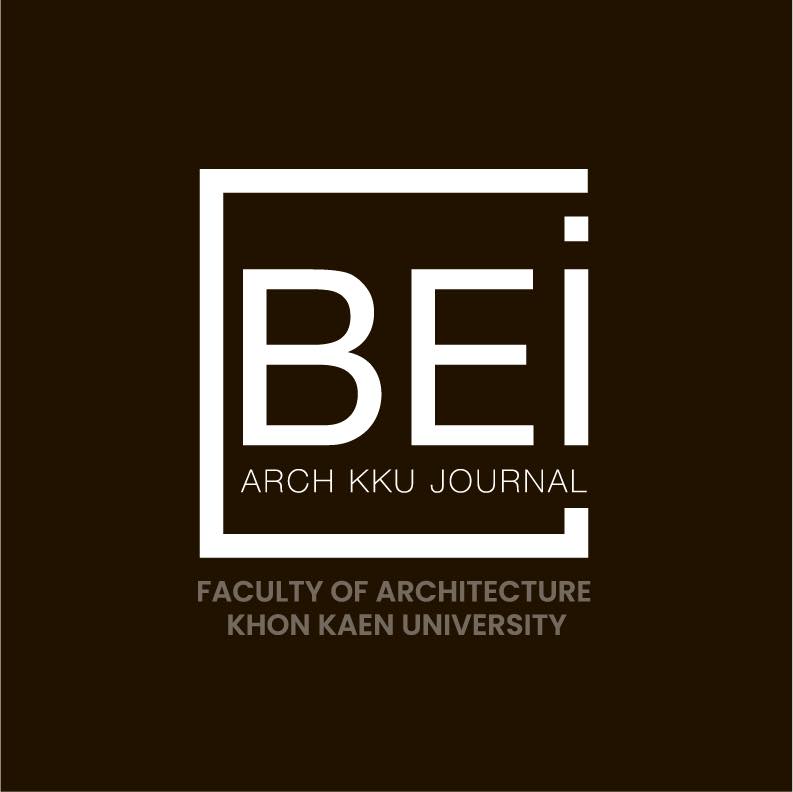Urban Design for Inclusive Learning Spaces: The Design of Urban Spaces for People with Special Needs in Bangkok Metropolis
DOI:
https://doi.org/10.14456/bei.2024.29คำสำคัญ:
Bangkok, Inclusive, People with special needs, Urban design, Urban spaceบทคัดย่อ
An inclusive society is crucial for sustainable development. Herein, the aim is to include people with diverse needs such that everyone has the right to freedom of expression, respects humanity, and has the potential for learning and self-development. This study is conducted, using qualitative methods to present guidelines for designing and improving the design of public learning spaces for people with special needs. Eighteen experts were recruited by purposive sampling. A snowball technique was also used whereby one-on-one in-depth interviews were held via an online platform to elicit data. Accordingly, a semi-structured interview was developed. Interview questions were related to each group of experts. Five specialists were skilled in special educational psychology or psychiatry. Five specialists were urban design and landscape architects. Three officers were attached to the social development department along with three parents and two people with special needs. After the interview, datas were transcribed verbatim, then analyzed, using the content analysis technique. The findings were reread several times before proposing guidelines. The challenges that face Bangkok Metropolis to create public learning spaces that can support people with special needs are numerous. Demands are many, including the misconcept of an inclusive city for all, lack of basic safety in accessing and using public spaces plus a lack of landscape architects who understand people with special needs. Guidelines are needed to design friendly spaces that support learning for people with special needs. Moreover, society has to understand and accept the differences in others. Changing the mindset of society from “social welfare” to “welfare state” drives the mechanism of “being part of the decision making process” to “participatory decision making”. Besides, experts must be hired who are skilled in special education and can integrate social agencies to support the quality of life for people with special needs. It is vital that the Bangkok administration provide more independence to local sectors to carry out policies required in their neighbourhoods.
References
Braun, V., & Clarke, V. (2006). Using thematic analysis in psychology. Qualitative Research
in Psychology, 3(2), 77–101. https://doi.org/10.1191/1478088706qp063oa
Case, B. J. (2003). Universal design. Pearson.
Children with special needs. (2019). M & L Special Needs Planning. Retrieved December 11,
, from https://specialneedsplanning.net/children-with-special-needs/
Commission for Architecture and the Built Environment [CABE]. (2006). The principles of
inclusive design (They include you). Commission for Architecture and the Built
Environment.
Department of Empowerment of Persons with Disabilities. (2022, March 31). Situation of
persons with disabilities in Thailand (Quarterly). Retrieved December 11, 2024,
from https://dep.go.th/images/uploads/files/Situation_mar65.pdf
Institute for Transportation & Development Policy (ITDP). (2022, June). Access and persons
with disabilities in urban areas. Retrieved December 11, 2024, from
Kenneth, J. D. (1993). Elements of urban management: Elementos de la gestion urbana.
World Bank Group. Retrieved December 11, 2024, from
https://documents1.worldbank.org/curated/en/437291468173050487/pdf/multipage.pdf
König, K. (2009). The child with special needs: Letters and essays on curative education. (E. R.
Erich, Trans.). Floris Books.
Mays, R., & Nordwall, S. (2024, April). What is an Anthroposophy? Retrieved December 11,
, from https://waldorfanswers.org/Anthroposophy.htm
Musigakama, P. (2023). Change the city to fighting COVID-19 with an inclusive approach.
Retrieved December 11, 2024, from
https://webportal.bangkok.go.th/upload/user/00000112/News/Panyapat/Panyapat40_1/
content03.pdf
Namutebi, S. (2022). A space for me? Urban management and disabled people’s access to the
city in Braamfontein [Research report]. University of the Witwatersrand. Retrieved
December 11, 2024, from https://wiredspace.wits.ac.za/items/e751e13d-3c36-40c4-
e43-d88d8b0bfefc
Pineda, V. S., & Corburn, J. (2020). Disability, urban health equity, and the coronavirus
pandemic: Promoting cities for all. Journal of Urban Health, 98(2), 308.
https://doi.org/10.1007/s11524-020-00465-2
Public space & the right to the city. (2019). UCLG-Planning. Retrieved December 11, 2024,
from https://www.uclg-planning.org/public-space-right-city
Pupphachai, U. (2019). Quality of urban space. Retrieved December 11, 2024, from https://
medium.com/umapupphachai/quality-of-urban-space-2f749900f320
Purnamasari, W. D., Hanun, I. F., Sasongko, W., & Parlindungan, J. (2022). Disabledfriendly public spaces in COVID-19 pandemic: Improving service facilities and
accessibility based on the user’s perception in Alun-Alun Batu city. IOP Conference
Series: Earth and Environmental Science, 1082(1), 012010.
https://doi.org/10.1088/1755-1315/1082/1/012010
Schaaf, R. C., & Davies, P. L. (2010). Evolution of the sensory integration frame of
reference. The American Journal of Occupational Therapy, 64(3), 363–367.
https://doi.org/10.5014/ajot.2010.090000
Sripakdee, N. (2018, November 5). EP.1: The twelve senses: Philosophy of human growth
from the “cell” and “soul”. The Potential. Retrieved December 11, 2024, from
https://thepotential.org/knowledge/the-twelve-senses-1/
Thanapet, K., Serisakul, N., & Khayankij, S. (2022). Factors and indicators in quality
assessment of urban public spaces according to the perception of people with special
needs. Journal of National Educational Testing and Assessment, 3(2), 90–109.
Retrieved December 11, 2024, from https://so02.tcithaijo.org/index.php/JOURNALNIETS/article/view/258740/175029
UNESCO. (2022, November 3). Social inclusion. UNESCO Bangkok Asia and Pacific
Regional Bureau for Education. Retrieved December 11, 2024, from
https://www.unesco.org/en/socialinclusion-factsheet
United Nations Children’s Fund [UNICEF]. (2022). Executive summary 2022 disability
survey. Retrieved December 11, 2024, from
https://www.unicef.org/thailand/media/11671/file/Disability%
Waldorf Publications. (2016a). Twelve senses: Not just five in the human being - Part I.
Retrieved December 11, 2024, from https://www.waldorfpublications.org/blogs/booknews/twelve-senses-not-just-five-in-the-human-being
Wang, Y., & Cai, G. (2017). Reinvigorating urban under space: Towards a new type of
public landscape. Nakara: Journal of Environmental Design and Planning, 13, 41–51.
Retrieved December 11, 2024, from
https://ph01.tcithaijo.org/index.php/nakhara/article/view/104608
Downloads
เผยแพร่แล้ว
How to Cite
ฉบับ
บท
License
Copyright (c) 2024 สิ่งแวดล้อมสรรค์สร้างวินิจฉัย

This work is licensed under a Creative Commons Attribution-NonCommercial-NoDerivatives 4.0 International License.
ทัศนะและข้อคิดเห็นของบทความที่ปรากฏในวารสารฉบับนี้เป็นของผู้เขียนแต่ละท่าน ไม่ถือว่าเป็นทัศนะและความรับผิดชอบของกองบรรณาธิการ



